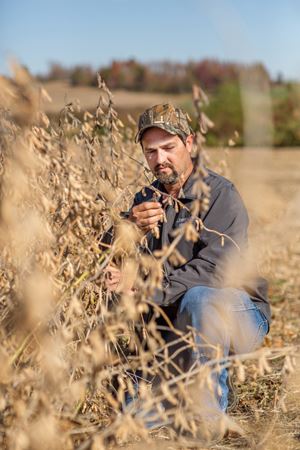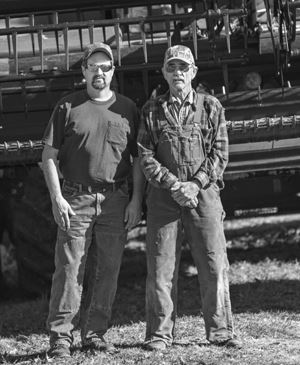|
A Mad, Mad Weed
Farmer Finds One-Step Method Curbs Weeds Best
BETTY VALLE GEGG-NAEGER
MidAmerica Farmer Grower
OLMSTED, ILL.
LibertyLink soybeans will always find a place in Bryan Curry’s fields. The Olmsted, Ill., producer who has been farming for 20 years raises about 1,700 to 1,800 acres of soybeans a year, and for the past two years all of his crop is LibertyLink.
“It helps us keep clean fields,” he explains. “We don’t have the resistance out there. It’s usually a one- to two-pass system, instead of six or seven trips across the field. It saves on time, chemical and everything else.”
A third generation farmer, Curry remembers the 200-acre cattle and grain farm of his grandfather, John Curry. His father, Terry Curry, also raised cattle and grain. John retired about 1980, and Terry took over, increasing the acreage to 1,400 acres. John was still helping on the farm about 1990 when Bryan got involved at the age of 13. When John died about 18 years ago, the farm fell into Terry’s and Bryan’s hands. Today they’re still working together.
“I sold the cattle about four years ago and went to all grain,” Bryan explained. He and Terry also were able to increase the acreage to 2,400 acres. All of the fields are rolling hills, dryland, with clay dirt.
While wheat has been a part of the mix in the past, the last few years they dropped that crop. “We’re just not much of a wheat farmer,” Bryan said. “”We’re not willing to put all the money into it to make 110 bushels.”

Bryan Curry, third generation Illinois farmer, raises 1,700 to 1,800 acres of soybeans a year
all of which are LibertyLink.
Photo Courtesy of Bayer CropScience

Bryan Curry (left) and his father Terry Curry still work the farm together and have increased the acreage to 2,400 acres.
Photo Courtesy of Bayer CropScience
They’ve even cut their corn acreage back due to prices, dropping from 800 or 900 acres back to 500 acres the past year.
“Corn yields were really good this year, but the prices were low,” he said. “In the past our average yield was 170 to 180 bushels, but this year we were a little over 200 bushels overall.
He attributes the increased corn yield to the weather, and to his overall farming practices. With the cut in his other crops, soybeans is now his main crop.
“We try to rotate some, but since we don’t have that many corn acres, some of our soybeans are just continuous,” he said. “That’s why we have lots of problems with weeds. We aren’t able to rotate them out of our soybeans.”
This year he had record soybean yields, a lot of 70 to 80 bushels to the acre, even some test areas where yields were in the mid-90s. Much of that increase he attributes to the quality of the seed. Adequate rainfall this year also helped boost the yield. He likes raising soybeans because the inputs aren’t as high and soybeans provide better returns.
He soil samples every two years and bases his fertility program on the results of that. As far as fertility, he tries to keep those inputs at the optimum range that research has proven is best.
“We try to keep our organic matter up with our no-till, and keep our soil nutrient levels where they need to be,” he said. He shoots for 160,000 seeds per acre in soybeans.
“We’ve tried higher amounts and they just grow real tall and fall over,” he said. “They just don’t yield as well as they do in the 150,000, 160,000 range. For some people that’s too much, but we no-till. When you no-till, the ground is rougher and you are not going to get all the beans up with no-till. Average seeding is 150,000 for our area. With no-till it’s hard to cut back and take the risk of having a real light stand.”
Because of no-till he needs few employees. Besides his father, a stepson, Jerron Goins, and a brother, Terry Jr., help out occasionally.
Mershmann Seeds are his choice for soybean seed. His best yields come from the late Group III beans.
“We’ve tried a lot of different companies over the years, and Merschmann is much better than anyone else’s offers,” Bryan said. “We attribute a lot of our yields to Merschmann Seed.”
Prior to switching to LibertyLink, he used Roundup, then it came to the point where he had to get into the new technology in a new decade. The old program just didn’t work anymore.
“They have different programs out there to control the weeds that require more than one mode of action,” Bryan said. “You have to be a chemist to mix all the chemicals to get control, and most of the time it just made the weeds mad! A lot of people just don’t want to admit they have a weed problem. They just deal with it and end up having a mess. ‘Recipes,’ they call them; unfortunately, the recipe is mixing the additive that has the ability to control the weeds.”
He recalls driving by a field with weeds in it one year, and the next year driving by again and there’s more weeds.
“The next year you drive by and the weeds have taken over,” Bryan said. “And they say, ‘oh, yes, it just got away from me.’ They are mostly in denial, and they are loyal to the seed companies. If their company doesn’t offer LibertyLink, they don’t plant it.”
He finds himself thinking, how much are they willing to let ‘loyalty’ cost them?
“It’s costing you money and yield, and uncontrollable weeds,” he charges.
Curry has the solution: “Every seed company should offer the LibertyLink trait.” ∆
BETTY VALLE GEGG-NAEGER: Senior Staff Writer, MidAmerica Farmer Grower
|
|